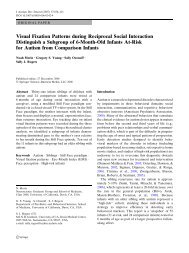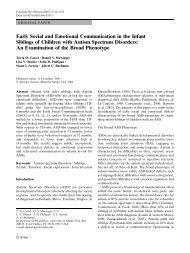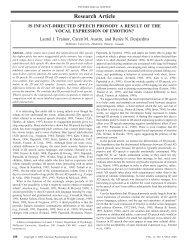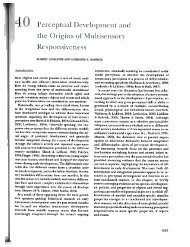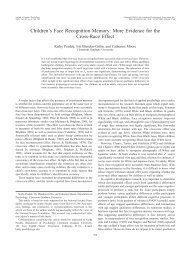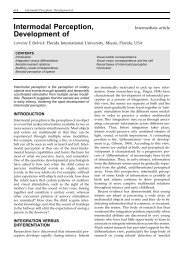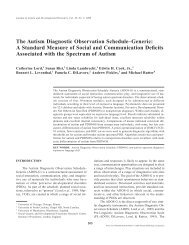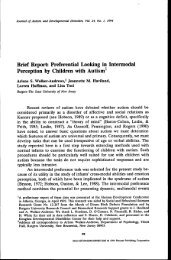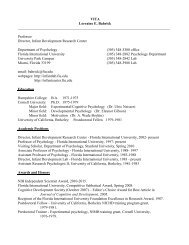The role of the mother's voice in developing mother's ... - FIU Infant Lab
The role of the mother's voice in developing mother's ... - FIU Infant Lab
The role of the mother's voice in developing mother's ... - FIU Infant Lab
Create successful ePaper yourself
Turn your PDF publications into a flip-book with our unique Google optimized e-Paper software.
42<br />
F. Z. Sai<br />
stranger). <strong>Infant</strong>s showed more head turns towards <strong>the</strong>ir mo<strong>the</strong>r’s face<br />
(M ¼ 3:95) than towards <strong>the</strong> female stranger’s face (M ¼ 2:7) and this difference<br />
was significant (Fðl; 9Þ ¼15:4, p ¼ 0:003). Also, neonates turned <strong>the</strong>ir heads more<br />
towards <strong>the</strong> mo<strong>the</strong>r on trial 2 (M ¼ 4:1) than on Trial 1 (M ¼ 3:8), and this<br />
difference was significant (Fð1; 9Þ ¼0:018, p ¼ ns), (Table 4). <strong>The</strong> <strong>in</strong>teraction <strong>of</strong><br />
face x trial failed to reach significance (Fðl; 9Þ ¼0:78, p ¼ ns). Preferences for <strong>the</strong><br />
mo<strong>the</strong>r and <strong>the</strong> stranger are given <strong>in</strong> Figure 4.<br />
From <strong>the</strong> f<strong>in</strong>d<strong>in</strong>gs with both trials <strong>in</strong>cluded, newborn <strong>in</strong>fants demonstrated<br />
more head turns towards <strong>the</strong>ir mo<strong>the</strong>r’s face (M ¼ 7:9) than towards <strong>the</strong> female<br />
stranger (M ¼ 5:4). Fur<strong>the</strong>r, head movements were observed but were not<br />
considered as full head turns, as def<strong>in</strong>ed above. Preference for <strong>the</strong> mo<strong>the</strong>r’s face<br />
was fur<strong>the</strong>r replicated <strong>in</strong> <strong>the</strong> present study with non-Caucasian faces, and with<br />
head orientation as a response measure. A possible <strong>in</strong>terpretation <strong>of</strong> <strong>the</strong> f<strong>in</strong>d<strong>in</strong>gs<br />
is that s<strong>in</strong>ce both <strong>the</strong> mo<strong>the</strong>r’s <strong>voice</strong> and visual cues were available from birth to<br />
<strong>the</strong> time <strong>of</strong> test<strong>in</strong>g, neonates might have demonstrated a long-term memory effect<br />
for <strong>the</strong>ir mo<strong>the</strong>r’s <strong>voice</strong>–face relations <strong>in</strong> <strong>the</strong> recognition test.<br />
EXPERIMENT 4<br />
<strong>The</strong> purpose <strong>of</strong> this study was to determ<strong>in</strong>e whe<strong>the</strong>r <strong>the</strong> absence <strong>of</strong> <strong>the</strong> mo<strong>the</strong>r’s<br />
<strong>voice</strong>, from birth through test<strong>in</strong>g, would result <strong>in</strong> less head turns towards <strong>the</strong><br />
mo<strong>the</strong>r’s face.<br />
Method<br />
Participants<br />
<strong>The</strong>re were 15 participants (eight males and seven females) successfully tested<br />
<strong>in</strong> this experiment while a fur<strong>the</strong>r 10 <strong>in</strong>fants were elim<strong>in</strong>ated from <strong>the</strong> sample<br />
because <strong>of</strong> side bias <strong>in</strong> <strong>the</strong>ir look<strong>in</strong>g behaviour ðn ¼ 4Þ or fell asleep ðn ¼ 6Þ. <strong>The</strong><br />
mean age <strong>of</strong> <strong>the</strong> sample was 6.31 h (range 2–10), <strong>the</strong> mean birth weight was<br />
3.30 kg (range 2.98–3.60), <strong>the</strong> mean Apgar score after 5 m<strong>in</strong> was 9.50 range 7–10).<br />
<strong>The</strong>y were born and tested at <strong>the</strong> Maternity Department; Larbaa Hospital,<br />
Algeria.<br />
Procedure and Design<br />
<strong>The</strong> stimuli, apparatus and procedures were identical to those <strong>in</strong> Experiment 2,<br />
except head orientation was adopted as a dependent variable as <strong>in</strong> Experiment 3.<br />
Participants were randomly assigned to <strong>the</strong> test<strong>in</strong>g. A tra<strong>in</strong>ed observer, unaware<br />
<strong>of</strong> <strong>the</strong> subject’s mo<strong>the</strong>r, monitored head orientations us<strong>in</strong>g video tap<strong>in</strong>g. A<br />
second observer monitored head orientations for half <strong>of</strong> <strong>the</strong> subjects. Interobserver<br />
reliability was calculated and <strong>the</strong> correlation between observations <strong>of</strong><br />
<strong>the</strong> primary and secondary observer was high (Pearson r ¼ 0:87).<br />
RESULTS AND DISCUSSION<br />
Head orientations towards <strong>the</strong> mo<strong>the</strong>r and <strong>the</strong> stranger were calculated as before,<br />
and this <strong>in</strong>formation is set out <strong>in</strong> Table 5. <strong>The</strong> subjects had almost equal<br />
preferences for <strong>the</strong> faces <strong>of</strong> <strong>the</strong> mo<strong>the</strong>r (M ¼ 1:72) and that <strong>of</strong> <strong>the</strong> female stranger<br />
Copyright # 2004 John Wiley & Sons, Ltd. Inf. Child Dev. 14: 29–50 (2005)



